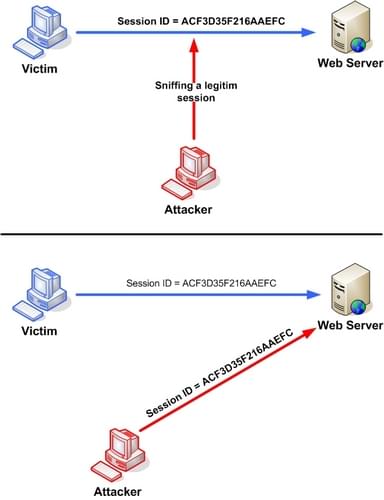

- #Session hijacking update
- #Session hijacking password
- #Session hijacking series
- #Session hijacking windows
Persistent cookies are usually stored on the user’s hard drive. Cookies that last beyond a user’s session (i.e., “Remember Me” option) are termed “persistent” cookies. These are termed “session cookies” or “non-persistent” cookies. Sometimes, cookies are set to expire (be deleted) upon closing the browser. In an HTML page, a session ID may be stored as a hidden field: A URL containing the session ID might look something like: Session IDs are commonly stored in cookies, URLs and hidden fields of Web pages. When the session is destroyed, the user’s data should also be deleted from the allocated memory space.Ī session ID is an identification string (usually a long, random, alpha-numeric string) that is transmitted between the client and the server. The session is destroyed when the user logs-out from the system or after a predefined period of inactivity.

The session is kept “alive” on the server as long as the user is logged on to the system. When a user logs into an application a session is created on the server in order to maintain the state for other requests originating from the same user.Īpplications use sessions to store parameters which are relevant to the user.
#Session hijacking series
A session is a series of interactions between two communication end points that occurs during the span of a single connection.

Consider using security tools such as firewalls and intrusion detection systems to detect and prevent unauthorized access to the network.
#Session hijacking windows
#Session hijacking password
#Session hijacking update
Regularly update software and ensure that all security patches are applied promptly.Use a modern, secure web browser with the latest security features enabled.Enable MFA (multi-factor authentication) on all accounts that offer it, particularly for any high-value accounts.Train employees to identify phishing emails and other social engineering tactics that attackers often use to deliver malware.Use anti-malware software and keep it up to date.Here are some tips to help prevent session hijacking attacks: To protect against session hijacking attacks like the one that targeted Linus Tech Tips, it's important to implement best practices and adopt a proactive approach to security. Session hijacking attacks are becoming more common and pose a significant threat to individuals and organizations. This type of attack is known as a session hijacking attack, where attackers steal session tokens to impersonate users and gain access to their accounts or systems. The malware was able to quickly access all user data from both Chrome and Microsoft Edge browsers installed on the machine, including session tokens, giving the attacker an exact copy of those browsers from the target machine that they could export. The attack was initiated when a member of the Linus Tech Tips team unknowingly downloaded a malware-infected file disguised as a sponsorship offer from a potential partner. According to reports, the attacker was able to bypass the need for password authentication by targeting session tokens, allowing them to take over the channel. Last night, the Linus Tech Tips Youtube channel was hacked, and its content was replaced with a well-known Bitcoin doubling scam.


 0 kommentar(er)
0 kommentar(er)
